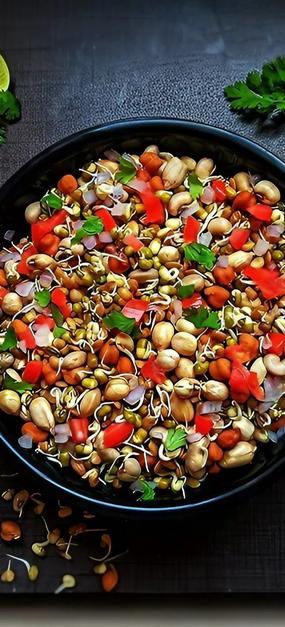One of the defining characteristics of Ayurveda, or the ancient Indian science of life, is the relationship that it has with the wisdom of nature.
Ayurveda teaches us that our bodies don’t exist in exception to the natural world. They are, instead, a part of it, integrated with it, and dependent on it for our health and wellbeing. In the modern age, however, we live in such a separate state from nature that we’ve forgotten the natural and instinctual ways in which to nourish ourselves. With industrialization making once-seasonal food available year-round, and the fact that we spend more and more of our lives inside, it’s easy to forget what it feels like to truly live in harmony with the rhythms of the seasons.
Why eating seasonally is important
Each season has a different effect on our bodies. Imagine for a moment taking a big bite of ice cream while you’re bundled up in scarves and mittens on a winter’s walk in January–not very pleasant, right? What about eating a hot bowl of barley soup while you’re lounging poolside on a sweltering August day? Pretty unappetizing. There’s a reason why your body reacts to these images–different types of food help your body get back into balance during different times of the year.
Acting against these natural inclinations can actually harm you, both inside and out. When you eat out of sync with nature, even if you eat an otherwise “healthy” diet, the consequences can include a compromised immune system, unhealthy weight gain or loss, poor skin and hair quality, and even an increased risk of more serious illnesses. Eating Ayurvedically, in accordance with the seasons, doesn’t just make you feel good in the moment, but is a powerful preventative health measure, too.
Ritucharya: Guidelines for the seasons
In Ayurvedic thought, each of us embodies a dominant natural constitution or Prakruti: either Vata, Pitta, or Kapha (or a combination of any of the above). Vata types are ruled by the qualities of air and space, Pitta types are ruled by fire and water, and Kapha types are ruled by water and earth. Each season pacifies or ignites these energies within us, meaning that our systems can be thrown out of balance if we don’t take measures to adapt our bodies to the weather.
Luckily, Ayurveda lays out a set of seasonal guidelines known as Ritucharya, with “ritu” translating to “season”, and “charya” translating to “guidelines”. These guidelines serve as prescriptions for diet and lifestyle changes throughout the year, including Ayurvedic detox treatments, and help us keep clear in our minds, fulfilled in our spirits, and vibrant in our bodies.
According to Ayurveda, the year is divided into two periods, each containing three seasons: Uttarayana, the cold months, which contains the seasons of Sharath, Hemanta, and Shishira, and Dakshinayana, the warm months, which contains the seasons Vasanta, Grishma, and Varsha.
Here’s how the energetic principles, or doshas, of Ayurveda flow throughout the year
| Dosha | Season for accumulation (Sanchaya) | Season for provocation (Prokopa) | Season for soothing (Shaman) |
|---|---|---|---|
| Vata | Grishma (mid-May to mid-July) | Varsha (mid-July to mid-September) | Sharath (mid-September to mid-November) |
| Pitta | Varsha (mid-July to mid-September) | Sharath (mid-September to mid-November) | Hemanta (mid-November to mid-January) |
| Kapha | Hemanta (mid-November to mid-January) | Vasanta (mid-March to mid-May) | Grishma (mid-May to mid-July) |
Sharath Ritucharya
Sharath Ritu begins in the middle of September and lasts until mid-November. As we get one last surge of warmth and dryness after the rainy season, your agni, or digestive fire, regains its strength. Water and fire are both prominent energies during this transitional time, which makes it the perfect period to begin to pacify those Pitta energies.
What to eat
The goal of this season is to transition smoothly into winter. In order to cleanse yourself and prep your digestive system for the heavier fare of the colder months, eat bitter, light, cold, astringent, and sweet foods that are easy on your stomach, and avoid foods high in fat and salt. The ideal Sharath diet includes rice, honey, green leafy veggies, tomatoes, root vegetables, pineapples, berries, plums, ghee (clarified butter), and other dairy products.
Recommended Ayurvedic treatments
Virechana: Virechana purifies the blood by removing toxins from the body through the gastrointestinal tract. This therapy is essentially a herbal laxative therapy that clears out your digestive system so that you can enter the next season refreshed and ready for heavier fare. The practice of Virechana is effective for reducing the severity of symptoms associated with this season’s typical imbalances.
Hemanta Ritucharya
Hemanta Ritu blows in during the middle of November and lasts until the middle of January. During this time, your agni is at its strongest. The elemental energies of earth and water are dominant, which means that fiery Pitta becomes grounded and pacified.
What to eat
The goal of this season is to keep you warm and nourished. Now’s the time to eat sweet, sour, and salty foods, as well as unctuous or oily dishes. Keep that digestive fire burning strong! Eat warming foods and lots of fermented dishes (like kimchi and sauerkraut), and avoid foods that are cold, light, and dry. The ideal Hemanta diet includes pumpkin, cabbage, spinach, corn, rice, carrots, potatoes, onions, beets, apples, dates, and dairy products.
Recommended Ayurvedic treatments
Virechana: Removes toxins and keeps your digestive system happy.
Abhyanga: Abhyanga is essentially a massage with warm herbal oils that are designed to address your specific dosha’s needs. This therapy can be done by a practitioner or on your own and keeps your skin moisturized and protected.
Swedana: Swedana is kind of like using a sauna! Herbal steam helps you sweat out toxins, release tension, and help with your circulation. It’s great for keeping warm, too!
Shishira Ritucharya
The cold settles in for a few months in Shishira Ritu, which lasts from mid-January until mid-March. This wet, cold season brings with it an increase in heavy Kapha energies, which means that your agni needs to burn even brighter to keep things balanced.
What to eat
Keep up with the diet you’ve established during the Hemanta Ritu, with lots of sweet, sour, salty, fatty, and fermented foods served with warming spices. Avoid any astringent or cold foods. The ideal Shishira diet includes lots of dairy products, root vegetables, apples, grapes, rice, wheat, beans, and sweets (in moderation, of course!)
Recommended Ayurvedic treatments
Abhyanga: Warm oil keeps your skin hydrated and nourished in the harsh winter months.
Swedana: Keep sweating! Swedana is especially helpful during this time in keeping your body from going into winter hibernation.
Patar Potli: Patar potli is a massage performed with an herbal pouch full of heated medicinal herbs, stimulating your circulation, reducing inflammation, and freeing your muscles of tension.
Vasanta Ritucharya
As nature begins to stir back into life, we transition into the Dakshinayana, or the warmer months. Vasanta Ritu lasts from mid-March to mid-May, and earth and air energies combine to make this time a lively transitional period. Kapha energies start to disperse, which douses your agni and can cause a lot of discomforts.
What to eat
This is one of the more sensitive times for our body, so focus on eating easily-digestible bitter and astringent foods, and avoid cold, viscous, heavy, sour, and sweet dishes. The ideal Vasanta ritu diet includes gut-healthy foods like barley and honey and gently stimulating spices like coriander, cumin, turmeric, and fennel.
Recommended Ayurvedic treatments
Nasya: If you’ve ever used a NetiPot, you might have heard of Nasya. During allergy season, it’s important to clean out your respiratory system, including your nasal passages. Nasya involves clearing out excess mucus and adding therapeutic oil to keep things lubricated.
Grishma Ritucharya
It’s summer! Grishma Ritu lasts from Mid-May to Mid-July. Fire and air energies dominate this season, drying things out and increasing both the Pitta and Vata energies within the body. Your agni is at an all-time low, so keeping things light is a must.
What to eat
This is the time of year for sweet, light, cold, mineral-rich food. Eat lots of herbs and drink lots of fruit juices, and avoid sour, pungent, or warm foods. Keep hydrated with lots of water, and seek out antioxidants. The ideal Grishma diet includes lots of fresh fruit, and veggies like asparagus, cucumber, celery, and leafy greens.
Recommended Ayurvedic treatments
Abhyanga: Yup! Abhyanga again. Are you starting to see a pattern? This season is drying, so keeping your skin moisturized is a must.
Shirodhara: Shirodhara is a deeply relaxing therapy that involves a steady stream of warm oil that is poured onto the forehead. This blissful treatment is perfect for the chaotic state that fire and air can bring to the mind.
Varsha Ritucharya
Varsha Ritu takes place from mid-July to mid-September. This is typically a wet, rainy season, with earth and fire energies rising to the forefront. Your agni is heavily dampened during this season, so it’s time to get that fire roaring again.
What to eat
Salty, sour, and oily foods are the star of this season. Although you want your digestive fire to begin to pick up, avoid heavy foods at first and transition slowly through the season. The ideal Varsha diet avoids uncooked foods and favors warm, freshly-cooked meals. Help your digestion out with ginger and lemon, and eat a lot of thin soups.
Recommended Ayurvedic treatments
Panchakarma: Varsha is the perfect time for Panchakarma, a cleanse that takes you through five treatments: basti, nasya, swedana, abhyanga, and snehana. Reset yourself for the coming year and feel great!
Ritucharya for regions where there are only four seasons
In the US, Ritucharya is characterized by four seasons, unlike India where there are six seasons. The principal is the same; the doshas go through a cycle of accumulating, aggravating, and palliating in different seasons, and we have to balance them out with our lifestyle and diet.
Vata season runs from autumn and early winter, mid-September right up to January. Kapha season takes place from February to May, and Pitta season is June to mid-September. However, we always take our cues from nature: for instance, in northern states like Maine, the winter is longer.
We balance our diet through opposite qualities of doshas: for instance, in Pitta season, the weather is characterized by hot, light, and sharp qualities, so we counter it with cool, heavy, and bland food, avoiding sour, spicy, salty, and pungent foods. In the US, spring is the best time for Panchakarma, which is different than in India, where Varsha Ritu, or monsoon season, is the best time. Fall is another good season for this cleanse.
As always, consult your personal physician before undertaking any new health regime, and always begin Ayurvedic practices under the care of an Ayurvedic expert.
Based on inputs from Vaidya Trupti Joshi, an Ayurvedic Expert from India.
Paige Leigh Reist is a writer, editor, blogger, and writing instructor.




















